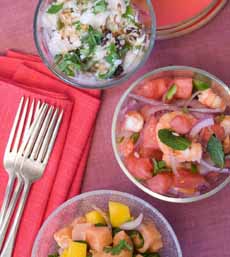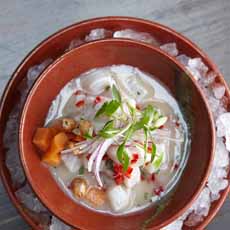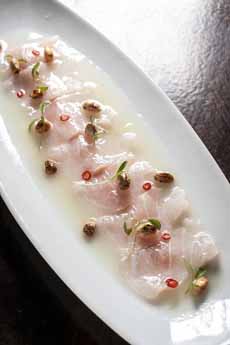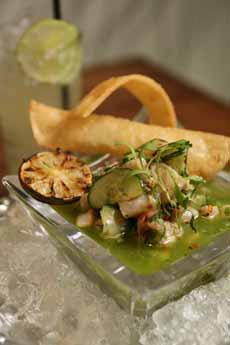FOOD FUN: Deconstructed Ceviche & The Different Types Of Raw Fish Dishes
 [1] Deconstructed ceviche at Seviche | Louisville.
|
June 28th is National Ceviche Day, so let’s have some fun with it.
Ceviche is delicious “health food.” Seviche Restaurant in Louisville, Kentucky serves a different ceviche any day. While there are traditional presentations, they’ve also served it deconstructed (photo #1). Instead of serving it traditionally—in a bowl or other container, resting in its marinade/curing liquid and topped with garnishes—the deconstruction in Photo #1 comprises: |
|
|
A BRIEF HISTORY OF CEVICHE & TIRADITO In South America, marinated raw fish dishes date to pre-Colombian times, when seafood was “cooked” (acid-cured) with a fruit called tumbo (Passiflora tarminina, a relative of passionfruit). The Incas cured fish in salt and fermented corn. In the 16th century, the Spaniards arrived with limes, onions and bell peppers, three essential ingredients in basic modern ceviche. Lime juice cured the fish, and marinating the sliced/diced onions and bell peppers mixed in with the seafood. Large kernels of roasted Inca corn are a common garnish. Ceviche is found in almost all restaurants on the coast of Peru, typically served with camote (sweet potato, which originated in Peru). It has been called “the flagship dish of coastal cuisine,” and is one of the most popular dishes in Peru [source]. Over time, fruits were incorporated; most popularly, tomatoes (native to Peru) and mango. The influx of Japanese immigrants to Peru in the 1970s brought with it chefs who cut and treated the fish in the manner of sashimi. A fusion dish developed called tiradito, with seafood cut sashimi-style (but thinner and longer), a spicy dressing incorporating Peruvian chiles, and more elaborate garnishes. Ceviche is variously spelled with a c or an s, with a v or a b. In Peru, cebiche is the spelling in Lima; although ceviche is used elsewhere in the country, and is the most common internationally. However, seviche was actually declared the proper spelling in 2004, by Peru’s National Institute of Culture. Additionally, historical texts refer to the dish as seviche, including those by the Academia Peruana de la Lengua (Peruvian Language Academy), founded in 1887 [source]. Since even in its homeland, the national dish has multiple spellings, don’t argue with anyone over which one is “correct.” Lobster Ceviche recipe |
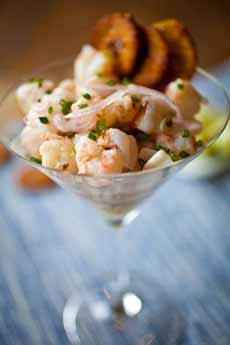 [5] Presentation in a Martini glass with plantain chips, at Elegant Affairs Caterers.
|
|
|
|
||
